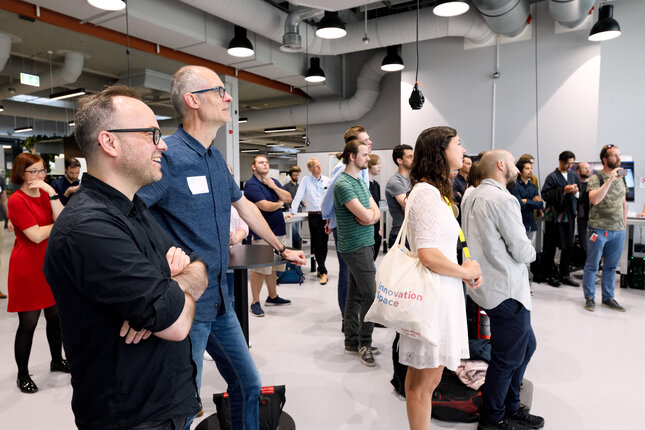With the innovative educational concept of Challenge-Based Learning (CBL), we are training the engineers of the future at TU/e. Starting this academic year, CBL will play a larger role in the curricula of all our bachelor's programs. Through a series of stories, we give a face to the form of education that sometimes takes students - and teachers - out of their comfort zone, but above all prepares them for the challenges they will tackle as engineers. In this episode: Miguel Bruns, one of TU/e's CBL pioneers and co-founder of TU/e innovation Space.
Miguel Bruns has big dreams and ambitions for our students, the engineers of the future. "Students will soon no longer come here for a degree in Biomedical Engineering, but because they want to develop new materials or improve health care, for example. Thanks to Challenge-Based Learning, here they can develop themselves into the great innovators of the future."
At the start of the new academic year in September, the Bachelor College 2.0 will be rolled out, with Challenge-Based Learning (CBL) taking on a larger, university-wide role in all curricula.
What is Challenge-Based Learning?
In this innovative educational concept, students work together to experience how their discipline can contribute to solving challenges from the world around us. They learn what knowledge and expertise is needed to do so and can immediately apply and deepen the knowledge they have acquired in practice by studying or doing research.
Together with students from other disciplines, as well as stakeholders from business, government or science, students learn to think at the system level. In the process, they also learn various other competencies such as collaboration, communication, planning and organizing.
Ready for more CBL?
"Are we ready for more CBL starting in September?" wonders Miguel Bruns, thinking aloud. "I think a third of our teachers are," says the associate professor at Industrial Design and one of TU/e's CBL pioneers. That number doesn't seem like much, but Bruns still considers it acceptable. "It just takes a small but motivated group to convince others."
Therefore, Bruns is not inclined to attach a fixed percentage to how much CBL will be taught in undergraduate courses starting in September. "Between 20 and 80 percent is fine. It should be up to the departments themselves to determine exactly how much."
Bruns is not only enthusiastic but is also a realist. "You should not expect all teachers to be equally committed and lavish with it or embrace CBL completely. It is not a teaching concept that immediately fits all subject areas. Some subject areas require more theoretical knowledge, so more traditional forms of teaching are more appropriate. This applies more to certain math and physics subjects, for example, than to experimental and design subjects," Bruns notes.

TU/e offers a wealth of knowledge and opportunities, let students sample as much of it as possible.
Miguel Bruns
Teachers are given a very different role with CBL: that of coaching students, both individually and at group level as they work on CBL challenges. "I believe you should introduce students to as many facets of our university as possible in their first year. TU/e offers a wealth of knowledge and opportunities, let students sample as much of it as possible.
"I know that not all students in their first year already know what they want to do, but it is a question to ask them. Because then they start thinking about it. If you don't ask them where their passion or ambition lies until their master's project, it's too late."
From passion to knowledge
"Where does your interest lie? Where would you like to work later? Do you have a passion for automotive, sustainable building, algorithms and AI, 3D printing, for example? The role of the coach is to point students toward the right courses to gain the knowledge needed to get started with their passion. That can be from anywhere, at different departments or at one of our four institutes."

CBL means letting go and daring more. That requires a change in mindset.
Miguel Bruns
"It's no longer just about conveying your disciplinary knowledge; above all, you have to show students the way and help them find direction. It means letting go and daring more. That requires a change in mindset."
Industrial Design as a foundation
The former program director of the Industrial Design department has a lot of experience with Challenge-Based Learning. "I have been working at Industrial Design for fourteen years now, where teaching was actually always done in CBL form, although it wasn't called that at the time.
"Students were given a project assignment and had to find the necessary knowledge for it themselves. In a portfolio they had to indicate what they had learned," he says, sitting at a table on floor 4 of Atlas, overlooking innovation Space, the TU/e expertise center for CBL and entrepreneurship.

"The structure at ID was very open. Before the introduction of the Bachelor College (in 2012, ed.), we were asked to translate that form of education into an educational concept in which students from other departments could also participate." That was the starting point of Challenge-Based Learning at TU/e.
Aalto inspo
"Together with Isabelle Reymen (now scientific director of TU/e innovation Space, ed.) and Rick de Lange (now professor of Mechanical Engineering, ed.) I set to work on forming an educational vision to bring CBL to the entire university," Bruns explains.
During a study trip of program directors to Aalto University in Finland, they were inspired by the innovative ecosystem for education and entrepreneurship - with a startup sauna and Design Factory. This was the spark from which innovation Space






